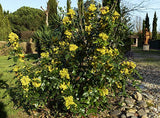Mahonia aquifolium
Mahonia aquifolium, also known as Oregon grape or holly-leaved barberry, is an evergreen shrub native to western North America. Here are some characteristics of this plant:
-
Size: Oregon grape typically grows 3-6 feet tall and wide, though it can reach up to 10 feet under ideal conditions.
-
Leaves: The leaves are leathery and glossy, with sharply toothed edges, and a distinct holly-like appearance. They are dark green in color, turning purple-red in the fall.
-
Flowers: The flowers are bright yellow, appearing in dense clusters in early spring. They are followed by small, blue-black berries that are edible and high in Vitamin C.
-
Growth habit: Oregon grape has a dense, upright growth habit, with multiple stems and a rounded shape.
-
Sun and soil requirements: Oregon grape prefers partial shade to full sun and well-draining, acidic soil.
-
Medicinal properties: The root and bark of Oregon grape contain several alkaloids, including berberine, which have been used for their antimicrobial and anti-inflammatory properties in traditional medicine.
-
Wildlife value: The flowers and berries of Oregon grape are attractive to bees, butterflies, and birds.
-
Landscape use: Oregon grape is often used as a low-growing, evergreen groundcover or as a shrub in naturalistic or woodland gardens.
-
Drought tolerance: Oregon grape is relatively drought tolerant once established.
-
Cold hardiness: Oregon grape is cold hardy and can survive in USDA Zones 5-9.












